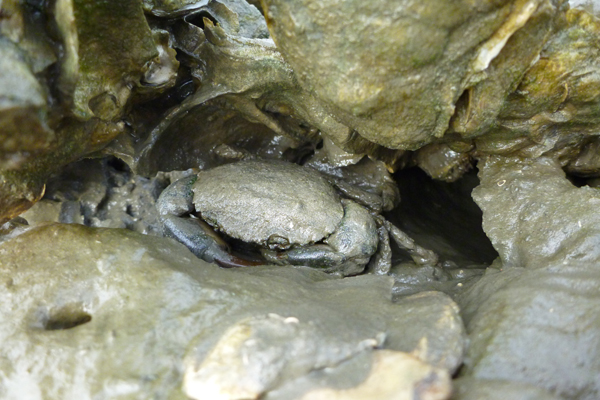Stuck in the middle with oysters and crabs

A mudcrab hiding from higher predators in an oyster reef. Photo courtesy of WFSU
He and his colleagues—associate professor Jon Grabowski and assistant professor Randall Hughes, ecology experts with labs at Northeastern’s Marine Science Center—think a similar pattern shows up in oyster reefs, where the behavior of the “middle child” in the predator-prey food chain plays a strong role in determining how the reef as a whole will fare. New research from the team, published online on Tuesday in the journal Ecology Letters, gives that hunch even more support.
The work complicates the evolution of a paradigm that has pervaded ecology since the 1960s, namely that the species at the top of the food web dictate the welfare of the entire system simply by eating.
For instance, observations in the Aleutian Islands in the 1970s showed that when sea otters were doing well, the nearby kelp forests below the ocean’s surface also thrived. This was due, theory said, to the fact that the otters’ feeding patterns naturally managed the sea urchin population, which feeds on kelp.
Fast-forward four decades and one sees a large body of evidence indicating that predators do more than eat; they frighten too. In the early 2000s, Grabowski showed that having a predatory fish scare the middle child has the same effect as predation itself. Likewise with the sea otters—just swimming around scares the urchins enough to send them into hiding and stop eating kelp.
These observations have led researchers to assume that the mere presence of a top predator is always beneficial for habitats like oysters and kelp, Kimbro said. “But,” he added, “we had a hunch that the lynch-pin of behavior is fickle. I mean, I can turn on a dime. Just ask my family when I miss snack time and the blood sugar gets low. So it seems logical that it’s not always going to be the same.”
To find out, the trio set up large experimental reefs along the eastern coast from Florida to North Carolina. At each site, they created three reefs: one containing just oysters; one containing oysters and their immediate predators, small mud crabs; and one containing the oysters and the mud crabs, as well as a scary fish and large crabs that feed on the mud crabs.
What they found surprised them. In North Carolina, the picture looked exactly the same as it did in the early 2000s, when Grabowski first did his behavior experiments. But from South Carolina to Florida, the fear of predation on the mud crabs actually had a negative effect on the overall reef.
That’s because as you move southward, the rivers that flow into the estuaries become muddier. And more mud means the healthy, thriving oysters start to get buried under layers of sediment. When top predators are scarce, the mud crabs feel safe enough to wander around the reef to eat baby oysters. As they do so, they kick off the river sediment and free the reef from being buried alive. It’s not so good for the reef when the crabs’ fear of being eaten prevents these reef strolls.
In North Carolina, there isn’t as much sediment on the reef so the oysters don’t benefit from the mud crabs’ walking around.
“Georgia and South Carolina are super-sized value meals,” Kimbro said. “It’s like the whole system is on steroids. There’s so much oyster food there, the crabs are so well fed they don’t wander far from their home in the reef anyway.” So, fear isn’t as important there.
Each of these hyper-local situations causes a unique effect, complicating the age-old story of the certain benefits of top predators. “This shows that you can’t just apply something across the board,” Kimbro said. Instead, researchers have to consider each local community individually.
“You could walk away from our paper thinking it’s just so complicated why even try,” Kimbro said. “But with careful experiments and so forth you can separate a predictable pattern from what seemingly is just noise.”
The research group’s next step is to see how the behavior of the middle predators affect the services that oysters provide to the urban coastal communities nearby. Oysters don’t just provide a tasty food source for humans (and job security for the oyster fishers that collect them), but they also filter the water of excess nutrients, which can have negative effects on the overall body of water.
As to whether the pattern Kimbro claims to have observed in The Brady Bunch is really true, well, “just go with it,” he said.
Media Contact
All latest news from the category: Ecology, The Environment and Conservation
This complex theme deals primarily with interactions between organisms and the environmental factors that impact them, but to a greater extent between individual inanimate environmental factors.
innovations-report offers informative reports and articles on topics such as climate protection, landscape conservation, ecological systems, wildlife and nature parks and ecosystem efficiency and balance.
Newest articles

First-of-its-kind study uses remote sensing to monitor plastic debris in rivers and lakes
Remote sensing creates a cost-effective solution to monitoring plastic pollution. A first-of-its-kind study from researchers at the University of Minnesota Twin Cities shows how remote sensing can help monitor and…

Laser-based artificial neuron mimics nerve cell functions at lightning speed
With a processing speed a billion times faster than nature, chip-based laser neuron could help advance AI tasks such as pattern recognition and sequence prediction. Researchers have developed a laser-based…

Optimising the processing of plastic waste
Just one look in the yellow bin reveals a colourful jumble of different types of plastic. However, the purer and more uniform plastic waste is, the easier it is to…



